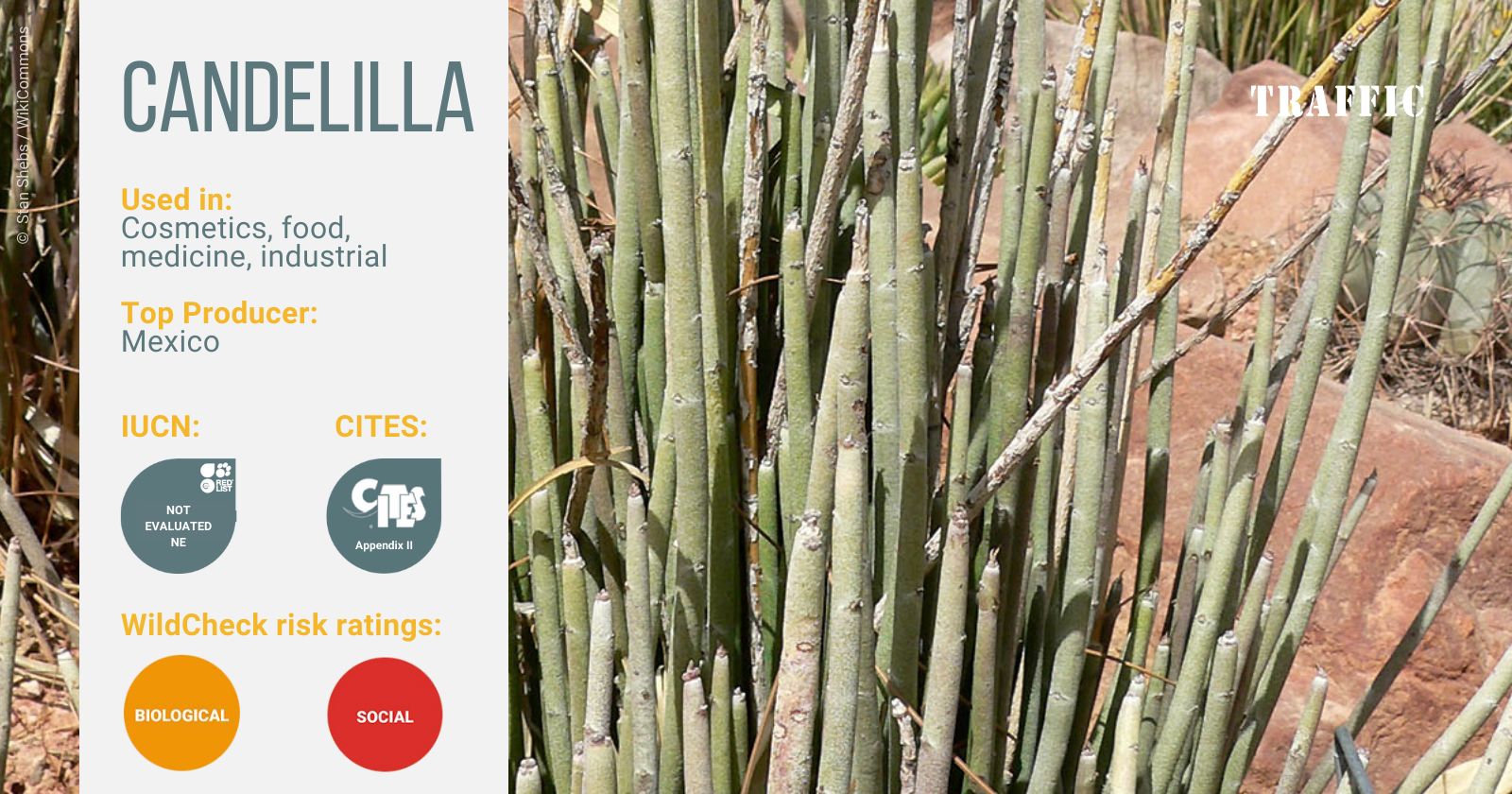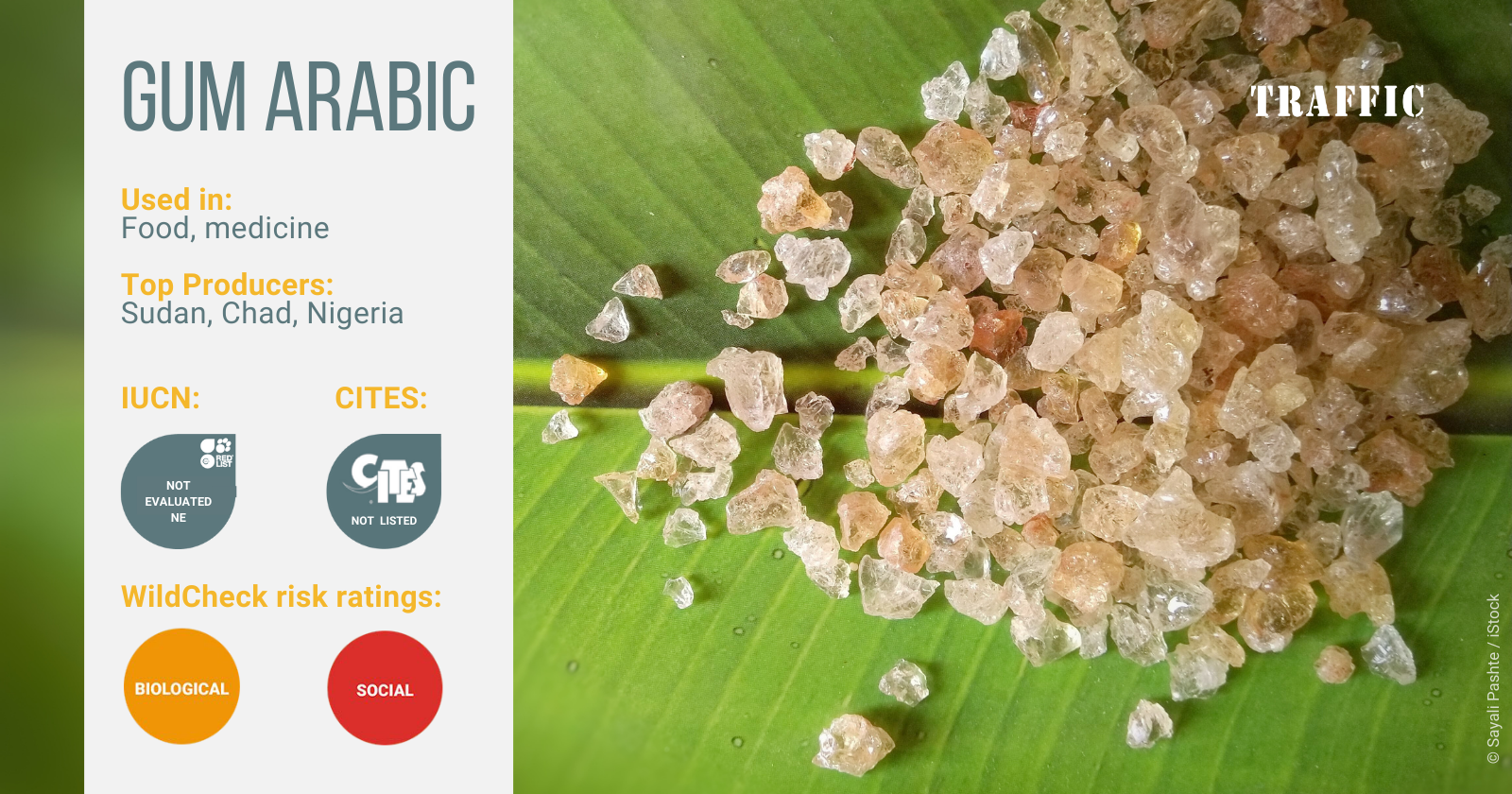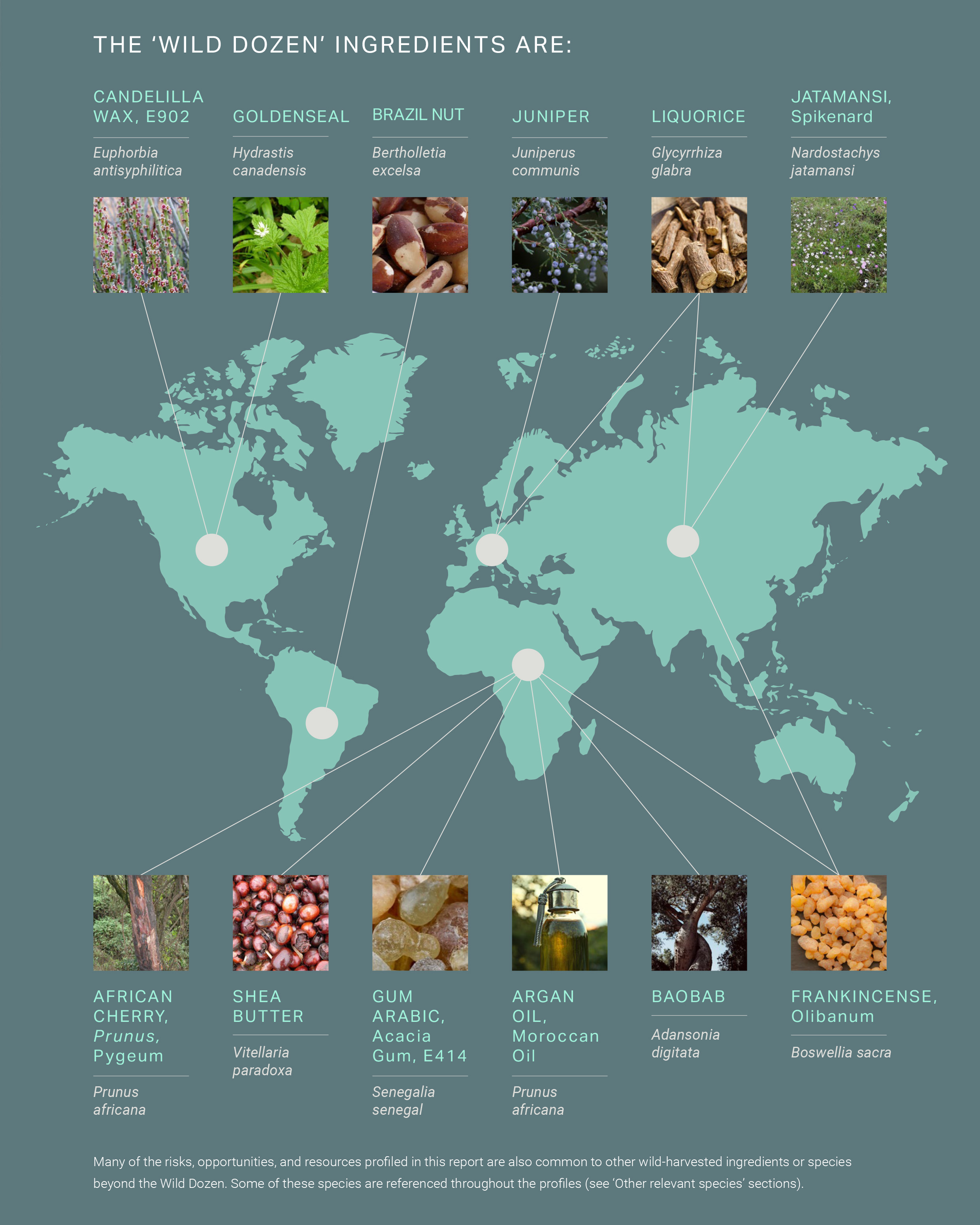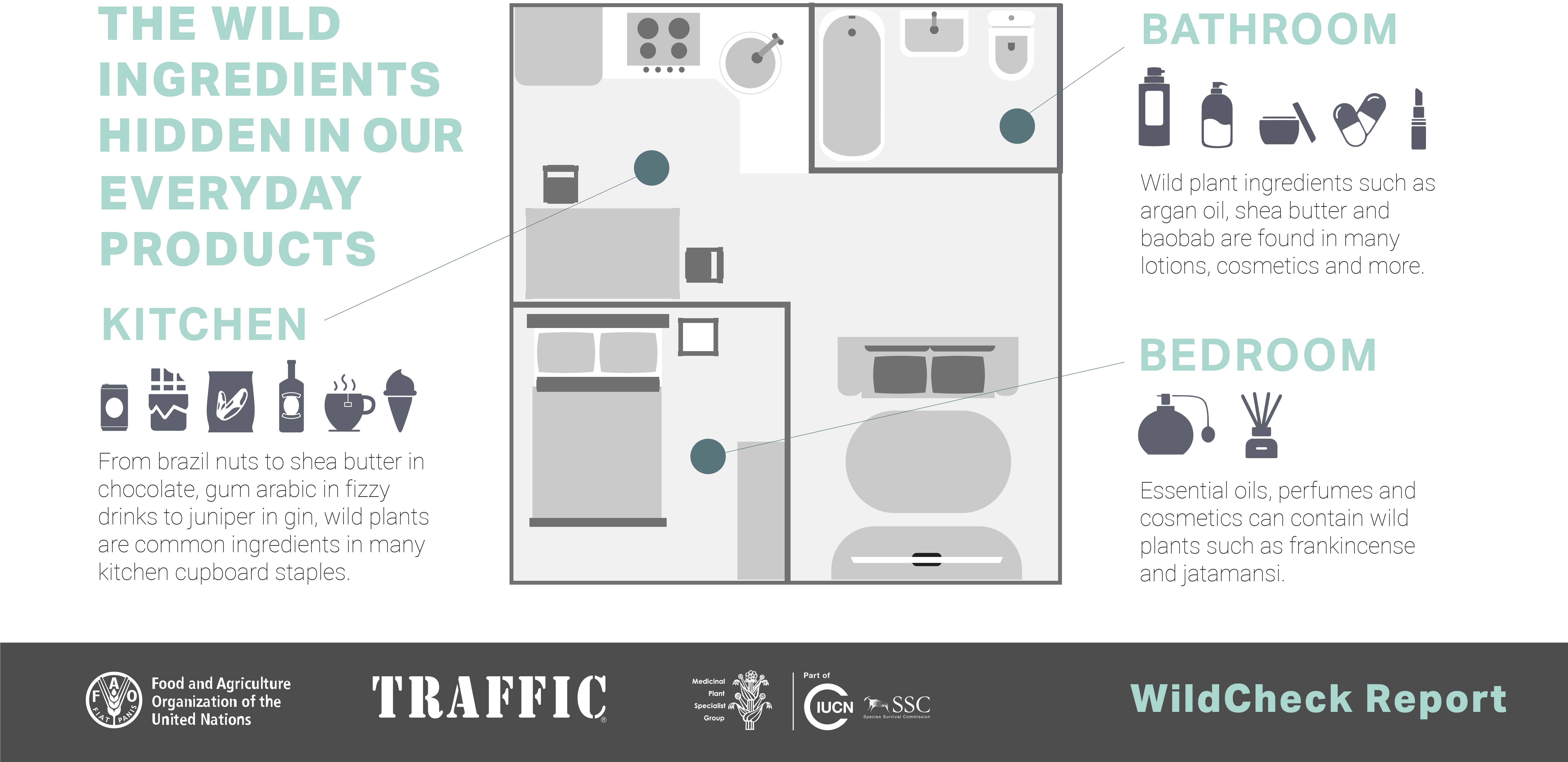New report highlights the risk and opportunities for wild-harvested plants, people and the planet
"It's time for businesses to invest in responsible sourcing of wild plant ingredients."
A new collaborative report by TRAFFIC, FAO and the IUCN Species Survival Commission Medicinal Plant Specialist Group looks at why governments, the private sector and consumers need to care about precious yet often overlooked wild-harvested plant ingredients and how responsible sourcing can support broader wildlife conservation, marginalised livelihoods and mitigate climate change.
The report WildCheck: Assessing risks and opportunities of trade in wild plant ingredients highlights the opportunities for sustainable trade development amid an unspoken surge in global demand for wild plant ingredients – an increase of more than 75 per cent in value over the past two decades.
Wild plants are significant across socio-economic groups and geographic regions. A wander through the kitchen may reveal Brazil nuts in your cupboard, gum arabic in your soda and liquorice in your herbal tea. Your bathroom may have makeup containing candelilla wax or skincare products made with shea butter or argan oil. Frankincense or Jatamansi may be found on the bedroom table as an ingredient in your perfume.
“Behind these largely invisible ingredients lie complex supply chains and significant environmental and social risks. But there are also opportunities for sustainable management that could benefit local ecosystems and the communities that depend on these plants," says Caitlin Schindler, TRAFFIC's Wild at Home Project Manager and lead author of the WildCheck report.
Thousands of plant species used in everyday products are at risk primarily due to habitat loss, climate change, and over-exploitation; they also suffer from a severe lack of data and attention. Of the 26000 wild-harvested plant ingredients with a well-known use, only 21 per cent have had their conservation status assessed, while nine per cent are considered threatened with extinction. The people who depend on specific species for vital income are also often exposed to socio-economic, political and sometimes health risks too.
Sven Walter, Senior Forestry Officer at FAO and co-author of the report, adds: “The sustainable use of wild plants has critical implications for food security and for millions of livelihoods around the world. It is time that wild plants are given more serious consideration in our efforts to protect and restore habitats, promote sustainable agrifood systems and build inclusive, resilient and sustainable economies, particularly as countries work on post-Covid recovery."
The report evaluates twelve flagship wild plant ingredients, dubbed the ‘Wild Dozen’, assigning them social and biological risk ratings to highlight where improvements can be made. Of the twelve flagship wild-harvested ingredients reviewed, the majority of the risk assessment results (both biological and social) are Medium or High, with only one Low biological and one Low social result. This shows that these ingredients must be considered in due diligence, policies, and purchasing decisions.
“The purpose of our social and biological risk ratings is not to dissuade businesses and consumers from using wild plant ingredients that can be harvested sustainably. On the contrary, it is to guide where steps can be taken to secure the long-term survival of wild-harvested species and availability of the sourced ingredients, improve marginalised livelihoods and enhance business ethics,” says Danna J. Leaman, Co-Chair of the IUCN SSC Medicinal Plant Specialist Group and co-author on the report.
Across the twelve ingredients, a range of engaging opportunities are noted including sustainable harvest, wildlife conservation and ecosystem restoration, access and benefit-sharing, research, partnerships, and engagement with best-practice standards and certification. The outlook for these flagships, and for wild ingredients as a whole, can be bright if appropriate actions such as those suggested throughout the report are taken by various stakeholders now.
With responsible sourcing, these ingredients can support broader wildlife conservation and improve the livelihoods of the 1 billion people, including some of the world's most vulnerable people, who are thought to depend on them.
“The report emphasises that it's time for businesses to invest in responsible sourcing of wild plant ingredients. There are a huge variety of opportunities waiting to be seized in responsible sourcing, including contributing to the conservation of iconic animals and supporting the livelihoods of harvesters who depend on these plants,” said Caitlin Schindler.
Caitlin Schindler continued, “Other stakeholders have a role to play too. Governments and researchers must prioritise data collection and research on these important yet often invisible ingredients to secure an ongoing sustainable trade for plants and people.”
“It is an important year for the global biodiversity conservation effort, with governments, businesses and the public coming together around the ambitious Global Biodiversity Framework. Sustainable use of wild species, including wild plant resources in everyday products, is an important strategy to ensure the multiple benefits to nature and people,” said Anastasiya Timoshyna, TRAFFIC's Senior Programme Coordinator – Sustainable Trade.
The Wild Dozen
The flagship wild plant ingredients highlighted in the report are:
- Frankincense: Found in northeastern parts of Africa, as well as in Oman, Somalia and Yemen, its resin is used for incense, aromatherapy, cosmetics, perfumes and traditional medicines.
- Pygeum: Also listed in ingredients for medicines and herbal products as Prunus, African cherry, red stinkwood or African almond, this tree grows in forests across tropical Africa.
- Shea: grows across Africa, from Senegal to Uganda. Used widely in the food industry as a cocoa butter equivalent, it is also popular in cosmetics. Locally, it is used as a healthy cooking oil.
- Jatamansi: A perennial, aromatic plant that grows in the Himalayas, its roots are harvested for their medicinal properties.
- Gum arabic: This species grows in the gum belt region of Africa and is primarily used in the food and pharmaceutical industries as an additive, emulsifier or stabiliser. It is a popular ingredient in fizzy drinks.
- Goldenseal: Also known as ground raspberry, this species is native to eastern North America and is primarily used for medicinal products.
- Candelilla: Found in Mexico and parts of the southern United States, candelilla wax was once a common ingredient in chewing gum. Now, it is used as a food additive (E902) and in cosmetics and pharmaceuticals and industrial waxes and polishes.
- Argan: Also known as Moroccan oil, its anti-ageing properties make it a popular choice among European and North American consumers of cosmetics, while its oil is also used to treat several ailments, from acne to arthritis. It is harvested exclusively from Morocco.
- Baobab: The Adansonia digitata variety of this species is native to mainland Africa. Baobab powder is used as a food and beverage ingredient, while its seed oil is used as a cosmetic ingredient.
- Brazil nut: Harvested entirely from the wild, the tree is primarily exploited for its nutritious, edible nuts, which are packed with nutrients and antioxidants such as magnesium, zinc, protein and selenium. Its harvesting has contributed to preserving millions of hectares of Amazonian forests, which is why it is often called the cornerstone of Amazon Forest conservation.
- Liquorice: This perennial herb is native to Eurasia, northern Africa and western Asia and is primarily used for medicinal purposes, as a sweetener, as an ingredient in herbal teas, and in the tobacco industry.
- Juniper: Juniperus communis is a species of the temperate and subarctic northern hemisphere. Its berries are a key ingredient in gin manufacturing. They are also used as a food flavouring, an essential oil, an ingredient in cosmetics, and have a long history of use in traditional medicines and religion.
--- ENDS ---
About TRAFFIC:
TRAFFIC is a leading non-governmental organization working globally on trade in wild animals and plants in the context of biodiversity conservation and sustainable development whose mission is to ensure that trade in wild plants and animals is not a threat to the conservation of nature. More information at www.traffic.org
About FAO:
The Food and Agriculture Organization (FAO) is a specialised agency of the United Nations, supporting the transformation to more efficient, inclusive, resilient and sustainable agri-food systems. The conservation and sustainable use of wild plants and non-wood forest products is a key area of work in the FAO Forestry Division, with the aim of contributing to the sustainable management of the world’s forests, the conservation of biological diversity, and ultimately improving livelihoods, food security and nutrition. www.fao.org
About the IUCN Species Survival Commission
With over 10,500 members in 174 countries, the Species Survival Commission (SSC) is the largest of the six expert commissions of IUCN and enables IUCN to influence, encourage and assist societies to conserve biodiversity by building knowledge on the status and threats to species, providing advice, developing policies and guidelines, facilitating conservation planning, and catalysing conservation action. www.iucn.org/ssc
About the IUCN SSC Medicinal Plant
The IUCN SSC Medicinal Plant Specialist Group (MPSG) is a global network of specialists contributing within our own institutions and in our own regions, as well as world-wide, to the conservation and sustainable use of medicinal plants. The MPSG was founded in 1994 to increase global awareness of conservation threats to medicinal plants, and to promote sustainable use and conservation action.
Press release distributed by Pressat on behalf of TRAFFIC, on Tuesday 3 May, 2022. For more information subscribe and follow https://pressat.co.uk/
Wild Plants Species CITES Cosmetics Beauty Makeup Lotion Food Fizzy Drink Wax Chewing Gum Responsible Sourcing Sustainable Trade Business & Finance Environment & Nature Farming & Animals Food & Drink Government Health Manufacturing, Engineering & Energy Medical & Pharmaceutical Retail & Fashion Women & Beauty
You just read:
New report highlights the risk and opportunities for wild-harvested plants, people and the planet
News from this source:






